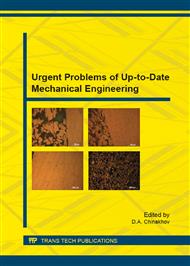[1]
H.D. Fair, R.F. Walker, Energetic materials. Physics and Chemistry of Inorganic Azides, Plenum Press, New York, (1977).
Google Scholar
[2]
D.V. Valuev, A.V. Valueva, A. Serikbol, An Apparatus for Implementing the Thermal Cycle for Plasma Surfacing of Metallurgical Equipment, Advanced Materials Research, 1040 (2014) 673-677.
DOI: 10.4028/www.scientific.net/amr.1040.673
Google Scholar
[3]
F.P. Bowden, A.D. Yoffe, Fast Reaction in Solids, Butterworth Scientific Publications, London, (1958).
Google Scholar
[4]
V. Yu. Zakharov, V.I. Krasheninin, E.G. Gazenaur, A.I. Gasanov, V. I. Yakunina, Physicochemical Processes in Heavy - Metal Azides and Dislocation Structure, Russian Physics Journal. 45 (6) (2002) 553-557.
DOI: 10.1023/a:1021191100748
Google Scholar
[5]
M.M. Kuklja, B.P. Aduev, E.D. Aluker, V.I. Krasheninin, A.G. Krechetov, A. Yu. Mitrofanov, Role of Electronic Excitations in Explosive Decomposition of Solids, Journal of Applied Physics. 89 (7) (2001) 4156-4166.
DOI: 10.1063/1.1350631
Google Scholar
[6]
A.B. Gordienko, Yu.N. Zhuravlev, A.S. Poplavnoi, Electronic Structure of Metal Azides, Physica Status Solidi (b), 198 (1994) 707-719.
DOI: 10.1002/pssb.2221980216
Google Scholar
[7]
A.A. Kabanov, E.M. Zingel, Effect of an Electric Field on the Thermal Decomposition of Solids, Russian Chemical Reviews, 44 (7) (1975) 538-551.
DOI: 10.1070/rc1975v044n07abeh002359
Google Scholar
[8]
V. Yu. Zakharov, V.I. Krasheninin, L.V. Kouzmina, Yu.A. Zakharov, The Control of Solid Phase Decomposition of Silver Azide by Noncontact Electric Field, Solid State Ionics, 101-103 (1997) 161-164.
DOI: 10.1016/s0167-2738(97)84025-8
Google Scholar
[9]
A.P. Rodzevich, E.G. Gazenaur, V.I. Krasheninin, On a Mechanism of an Electric Field Influence on Physicotecnical Specifications of Materials, Applied Mechanics and Materials, 379 (2013) 154-160.
DOI: 10.4028/www.scientific.net/amm.379.154
Google Scholar
[10]
A.P. Rodzevich, E.G. Gazenaur, A.S. Walnukova, L.V. Kuzmina, Features of Physical and Chemical Properties of Inorganic Salts, Grown in the Electric Field, Proceedings-2012, I (2012) 296-299.
DOI: 10.1109/ifost.2012.6357555
Google Scholar
[11]
A.P. Rodzevich, E.G. Gazenaur, G.M. Belokurov, The technology of production and treatment of materials in the electric field, Applied Mechanics and Materials, 682 (2014) 206-209.
DOI: 10.4028/www.scientific.net/amm.682.206
Google Scholar
[12]
H.G. Heal, A microgazometric procedure, Nature, 172 (1953).
Google Scholar
[13]
A.P. Rodzevich, E.G. Gazenaur, L.V. Kouzmina, V.I. Krasheninin, The Polarization of the Silver Azide in Electric Field, Applied Mechanics and Materials, 1040 (2014) 744-747.
DOI: 10.4028/www.scientific.net/amr.1040.744
Google Scholar


